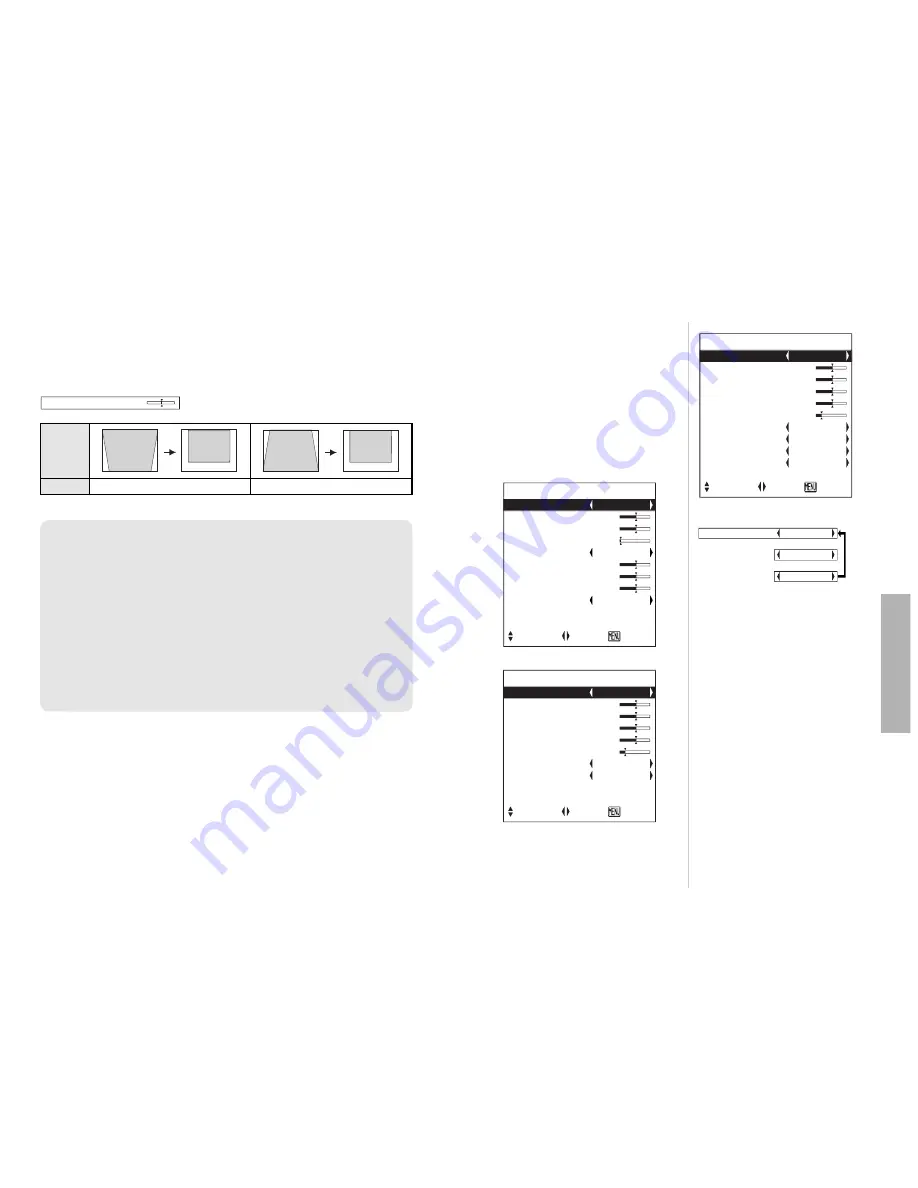
E
NGLISH
-35
Adjustments
and
settings
34-E
NGLISH
Correcting keystone distortion
Keystone distortion is corrected automatically when the projector’s automatic
setup function is used, but this correction will not apply if the screen itself is
tilted. In such cases, you can correct the keystone distortion manually with
the following procedure.
Vertical
keystone
distortion
correction
Operation
Press the
H
H
button.
Press the
I
I
button.
K E Y S T O N E 0
NOTE:
B
If you press the AUTO SETUP button after correcting the keystone
distortion manually, the automatic keystone correction function will
operate and the corrected picture will return to its previous incorrect
condition. To prevent this from happening, you can set “AUTO
KEYSTN” in the “OPTION1” menu to “OFF”. (Refer to page 42.)
B
Vertical keystone distortion can be corrected to ±30° of the angle of tilt.
However, the greater the correction amount, the more the picture
quality will deteriorate, and the harder it will become to achieve a good
level of focus. To obtain the best picture quality, set up the projector
and screen in such a way that the amount of keystone correction
required is as minimal as possible.
B
The picture size will also change when correction of keystone distortion
is carried out.
Vertical keystone distortion correction only.
Press the
F
or
G
button on the
projector or remote control unit to
select an item, and then press the
I
or
H
button to change the setting.
For items with bar scales, press the
ENTER button or the
I
or
H
button
to display the adjustment screen, and
then press the
I
or
H
button to make
the adjustment.
When an S-VIDEO/VIDEO signal is being input
Adjusting the picture
P I C T U R E M O D E N A T U R A L
[
S T A N D A R D
[
D Y N A M I C
P I C T U R E
P I C T U R E M O D E D Y N A M I C
C O N T R A S T 3 2
B R I G H T 3 2
S H A R P N E S S 0
C O L O R T E M P . S T A N D A R D
W - B A L R 3 2
W - B A L G 3 2
W - B A L B 3 2
A I O N
S I G N A L M O D E X G A
S T A N D A R D
S E L E C T A D J R E T R N
P I C T U R E
P I C T U R E M O D E S T A N D A R D
C O N T R A S T 3 2
B R I G H T 3 2
C O L O R 3 2
T I N T 3 2
S H A R P N E S S 2
C O L O R T E M P . S T A N D A R D
A I O N
T V - S Y S T E M A U T O
S T I L L M O D E O F F
S T A N D A R D
S E L E C T A D J R E T R N
When an RGB signal is being input
P I C T U R E
P I C T U R E M O D E S T A N D A R D
C O N T R A S T 3 2
B R I G H T 3 2
C O L O R 3 2
T I N T 3 2
S H A R P N E S S 2
C O L O R T E M P . S T A N D A R D
A I O N
S I G N A L M O D E 5 2 5 P
S T A N D A R D
S E L E C T A D J R E T R N
When an YP
B
P
R
signal is being input
PICTURE MODE
Select the picture mode that best
matches the image source and room
conditions.
The mode best used in dark rooms is
“NATURAL”. For rooms having
regular lighting conditions in use,
select “STANDARD”. For
exceptionally bright rooms, use
“DYNAMIC”.
CONTRAST
This adjusts the contrast of the
picture. (Adjust the “BRIGHT”
setting first if required before
adjusting the “CONTRAST” setting.)
The picture is bright:
I
button
The picture is dark:
H
button






























